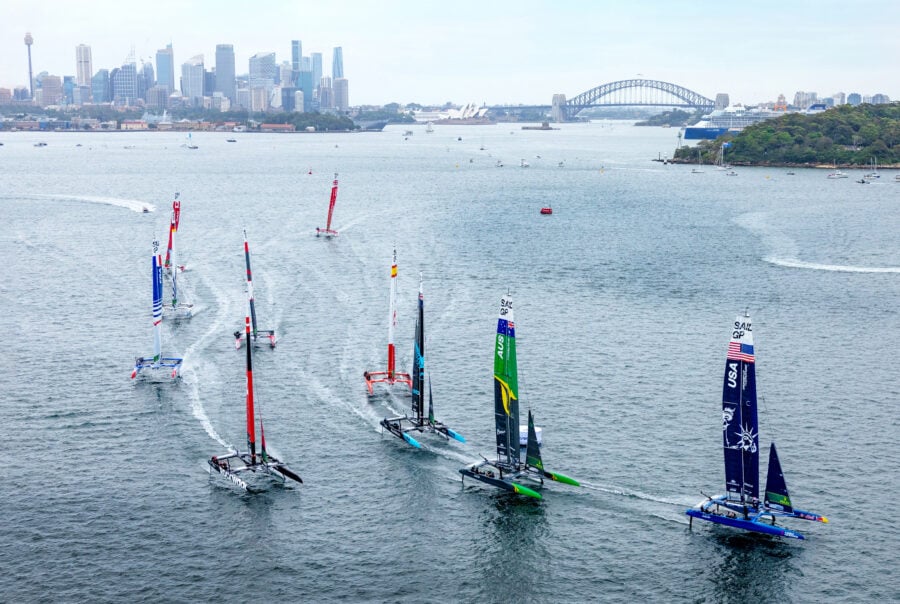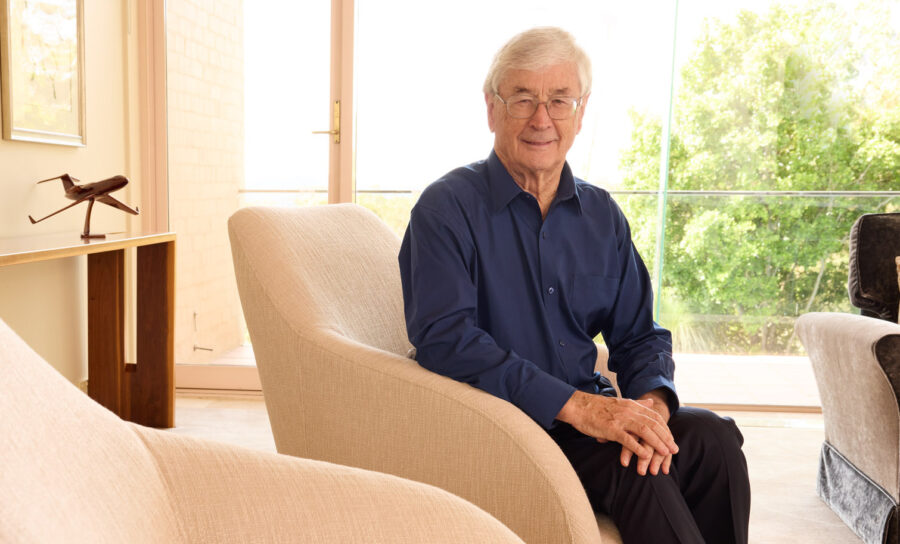Eyewitness account: Mawson’s Hut

ON THE ROOF OF an old wooden building, in the teeth of a gale, Tasmanian carpenter Mike Staples is at work, watched by a penguin. Mike struggles to keep his footing as he checks Baltic-pine planks worn thin by 95 years of Antarctic weather. The 90 km/h winds trying to knock him off his feet are nothing remarkable in “the home of the blizzard”, where a week-long hurricane-strength blow is the norm and a still day a rare exception.
“On a good day, it’s a very pretty place,” Mike says. “It’s not real flash on a bad day. You want to be indoors on a bad day – well tied down. But when I go up the hill behind the hut and look down, I sometimes think: ‘that’s what Mawson would have seen. That’s the view he would have had’.”
Expedition leader Ted Bugg, busy on the building near Mike, sees less to like: “It’s just a bastard of a place to live and work,” he says. “It’s hard to get around the place; it’s difficult to get water… the novelty wears off really quickly.”
After nearly three decades of thwarted dreams and stubborn effort, the last push to save Mawson’s Hut was under way. As the nation sweltered in the summer of 2006, a team of four from the Mawson’s Huts Foundation headed south to work on this heritage site in the windiest valley on Earth, at Cape Denison, eastern Antarctica.
They removed snow and ice from inside the hut, checked the cladding, secured loose planks and made plans to bolster up the failing roof with a fresh layer of timber. Without this continuing conservation work, the hut could be torn apart.
Since our first issue, Australian Geographic and its founder Dick Smith have championed the cause of Mawson’s Hut and the need to preserve it. This expedition, partly sponsored by the Australian Geographic Society, was another step in our long association with the heritage-listed icon.
CAPE DENISON JUTS INTO Commonwealth Bay about 2500 km due south of Hobart. Along 1.5 km of coastline, a few ridges of ice-free rock protrude from the icecap like the fingers of an outstretched hand. Mawson’s Hut sits between the thumb and index finger.
In summer, tens of thousands of Adélie penguins rally on the ridgetop rookeries, Weddell seals bask silently on the ice and delicate snow petrels wheel overhead. East and west of the cape, jagged ice cliffs curve to the horizon; offshore, the picturesque Mackellar Islands sit like iced cupcakes on the foam-flecked sea.
On a rare, windless day, Douglas Mawson chose this spot as the eastern base of his 1911-14 Australasian Antarctic Expedition (AAE). “The climate proved to be little more than one continuous blizzard the year round,” he wrote, “a hurricane of wind roaring for weeks together, pausing for breath only at odd hours.”
Gusts of more than 200 km/h blew men from their feet, scattered equipment and made travel over even the shortest distances almost impossible. “Anyone who had been out in it would gladly exchange for hell and chance his luck,” Mawson wrote.
As Robert Scott and Roald Amundsen raced each other to the South Pole, Mawson’s team quietly made breakthroughs in Antarctic geology, biology, meteorology, magnetism and oceanography, sent sledging parties across the uncharted icecap and used radio successfully for the first time on the continent. It was an expedition beyond maps, without reliable communications or external support and with little hope of rescue if something went wrong.
Mawson’s prefabricated Baltic-pine hut, which amazingly still stands after nearly a century, was modelled on a colonial Australian homestead, veranda and all: it’s a cross between a Queenslander and a pyramid. Constantly abraded by wind-blown ice, the thinning boards retain the golden freshness of new wood. Inside, where 18 men made their home during the AAE’s first year, reminders of the expedition adorn the bunks and shelves.
It was from this building in 1912 that Mawson set off on the epic 1000 km journey that cost the lives of Belgrave Ninnis and Xavier Mertz. Returning alone and almost dead from hunger and exhaustion, Mawson dragged a cut-down sledge 160 km across the icecap, staggering back to the hut just in time to see his ship disappear over the horizon for another year.
Outside, the scattered detritus of the expedition spreads downwind from the hut: tins and boots, dog chains, antenna wires and other rubbish jumbled in an untidy plume. Other Antarctic hut sites have long been cleaned up, but Mawson’s “artefact scatter” is untouched and remains a valuable resource for archaeologists. Three outbuildings, two of which are in ruins, lie nearby.
INSIDE THE MAIN HUT, Ted is cutting ice with a chainsaw. The tanned 50-year-old – a ranger at Cradle Mountain-Lake St Clair National Park in Tasmania – struggles in the confined space. Ted is missing his son’s second Christmas to volunteer here. As Ted prises free each 40 kg block of ice, fellow carpenter Marty Passingham spikes it with an ice-axe and drags it down a narrow passageway and out through a low door to add to an ever-growing pile. Passing penguins stop and watch briefly before going about their business. Ted and Marty work steadily and without talking beneath the hut’s 5 m high ceiling.
“It really takes it out of you because you’re constantly wet from perspiration and the spray that comes up over your body and up your sleeves and down your neck and melts and becomes cold,” Ted says. “And the chainsaw is potentially pretty unforgiving. Fortunately I haven’t ever had a close shave, so to speak – I’m mindful of the fact that we’re a long way from help. Having a chainsaw wound in Antarctica would not be a good look.”
The Mawson’s Huts Foundation has mounted four expeditions to Cape Denison – in 1997, 2000, 2002 and this one. Foundation chairman David Jensen says that one more expedition should secure the hut’s future to its centenary and beyond. “The main work to be done is the recladding of the roof of the main building and the removal of more ice and snow,” he says. “We need about $300,000 for the expedition this coming summer – then we plan to launch a $2 million fundraising campaign to give us all we require in the future for ongoing maintenance.”
Ted Bugg joined the project for the first trip in 1997 after seeing a newspaper advertisement seeking carpenters. He and 35-year-old Marty met while building a hut on Tasmania’s Overland Track in the winter of 2001 and the next year Marty, too, sailed south. Mike Staples signed up after taking part in other heritage projects for the Australian Antarctic Division.
An average of just 40 tourists make it to Cape Denison each year – the wind makes landings tricky and uncertain and it’s a long way from the attractions of the Antarctic Peninsula. Australian Geographic Society trustee and Aurora Expeditions chief Greg Mortimer says those lucky enough to visit the site are changed by the experience.
“They’re brought to their knees and silenced,” he says. “They’re very much awed by the vigour of the place of course, but the combination of elements and the tiny human toehold there, that has a nice impact on people. It’s a great place for getting a sense of human frailty.”
Tourist Eric Kelly, from Melbourne, who saved for nearly 40 years to fulfil his schoolboy dream of seeing Mawson’s Hut, says the experience had left him in awe of Mawson and his men. “I expected something a bit bigger – I couldn’t believe that 18 people could live in that small area for so long. The thing that stood out the most was the fragility of it more than anything. And yet it still stands.”
An eye-witness account
ON THE EVENING OF 4 January 1931, the research vessel Discovery rounded Cape Denison and limped into Commonwealth Bay after weathering a hurricane and the heaving, frenzied, grinding ice masses of the berg-strewn Durville Sea. Discovery was hosting the British, Australian and New Zealand Antarctic Research Expedition (BANZARE), led by a man who knew Commonwealth Bay as well as any: Sir Douglas Mawson, scientist, explorer and leader of the 1911-14 Australian Antarctic Expedition (AAE).
Among those aboard with Mawson were two fellow AAE -veterans, photographer Frank Hurley and magnetician Alec Kennedy, and BANZARE’s 24-year-old chemist and hydrologist, Alf Howard.
Not long before his 100th birthday last April, Dr Alf Howard AM – BANZARE’s longest surviving member, and a previous winner of the Australian Geographic Society’s Lifetime of Adventure award – still vividly recalled Discovery’s voyage to Anna Bemrose.
On the morning of 5 January 1931, Alf joined Mawson and other scientists in the motor launch heading ashore at Commonwealth Bay. It was sunny and the wind had dropped.
“As we approached shore Sir Douglas, Hurley and Kennedy couldn’t wait to view their old living quarters, which they had not seen for 17 years,” said Alf. “Boots and shattered fragments of wireless masts were scattered outside the hut. The only way to enter was from the roof. [We] lowered ourselves carefully through a skylight and landed on a carpet of solid ice.
“Conscious that Hurley wanted to photograph inside, we were careful not to touch anything. The ice formations were unbelievable. The old hut was festooned with bulbous, crystal-like stalagmites and stalactites of ice. We came across a cubicle tightly filled with snow and hard ice, which turned out to be Sir Douglas’s. Only the bunk was ice-free. I recall that it was relatively easy to move around the main living area, though the main entrance was choked with snow and ice. It was silent and eerie inside – signs of the 1911-14 expedition were everywhere.
“We could just make out some of Hurley’s old photographic equipment in the darkroom. I remember there were tinned foods, slabs of chocolate and a couple of bottles of Russian stout, which were brought back to the ship and later consumed with relish in the wardroom.”
The hut needed to be reinforced, but Discovery lacked spare materials for the task, so the Commonwealth Bay visit became a relaxing stopover. “Besides a bit of magnetic work we were more or less tourists,” Alf said. “It was unusually warm and we soon began to doff much of our heavy clobber. Some of us were badly sunburnt. Much time was spent observing the antics of the Adélie penguins with their young chicks and the Weddell seals, which thickly populated the -surrounding ice flats. I can remember sort of going a few hundred yards up a slope and then sliding down on my hands and coming a cropper.
“The following day many of us were desperately tired as no-one had slept much. Shortly after 5.30 p.m. on 6 January 1931 the Discovery heaved anchor and steered west.”
Source: Australian Geographic Issue 83 (July – Sep 2006)




